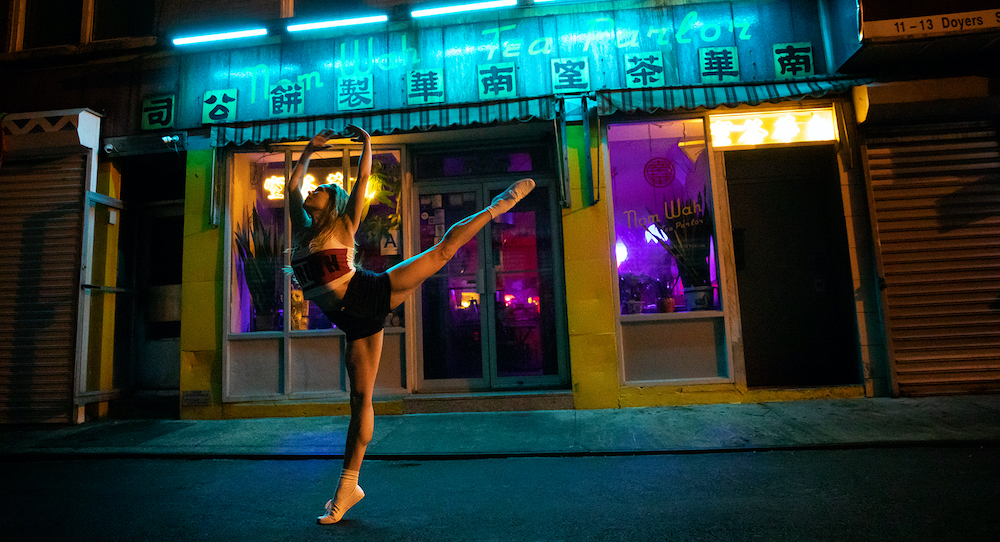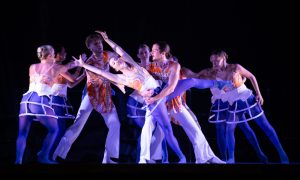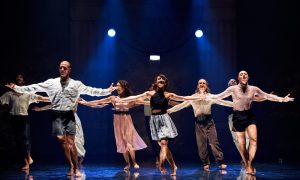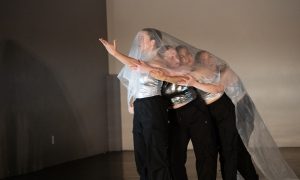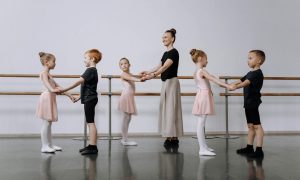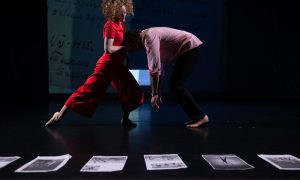October 27-31, 2020.
Streaming online, filmed in the Lincoln Center Plaza and other sites in New York City.
Lincoln Center: there’s a magic that hangs in the air, over fountains flowing and pools reflecting the grand and opulent buildings behind them. As a passionate lover of dance, I like to think that the performances happening in those buildings — arguably, the pinnacle of dance and other performing arts in the nation, and perhaps even in the world — stir and circulate that magic. Zooming out from Manhattan’s Columbus Circle for a moment: with the exception of site-specific dance, the art form isn’t as much about the space where it’s danced as it is about movement, other aesthetic elements (costume, lighting and music) and how those media come together.
Yet, there is a magic to a theater space; in and out of the building, one can feel an energetic hum from performances past and future. New York City Ballet (NYCB) can’t currently dance in Lincoln Center due to COVID-19. Through the New Works Festival in the Fall 2020 Digital Season, however, the company explored and honored the magic of that space — and beyond that, of New York City at large.
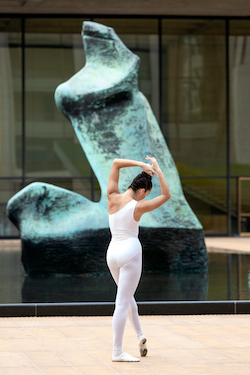
Sidra Bell’s pixelation in a wave (Within Wires) had movement that was highly architectural: sometimes angular, sometimes multi-linear shapes pause, in staccato rhythm. These postural shapes were clear and resonant. The dancers managed to flow through them, rather than letting their movement become static within the shapes — impressively so. The music, composed by Bell’s father, Dennis Bell, had suspension in the notes that supported these movement qualities. The black and white costumes had intriguing cuts and shapes, offering aesthetic intrigue and also supporting those movement qualities.
Reflecting on this quality, I thought about the highly poetic title “pixelation in wave”; a wave flows, but like a pixel within a digital picture, its individual drops of water are distinct. The dancers’ bodies seemed to reflect the architecture of Lincoln Center Plaza all around them, embodying the inanimate to make it animate. This led me to think to myself, without people, what remains of a city? As people stay inside through COVID, what is left to energize and characterize it?
In that tone, the score had a mournful quality, such as in its suspension of notes. As the dancers moved apart in space (apart from one pair partnering, which I assumed was COVID-safe through these dancers already living together or rapid testing), I thought about walking past grand buildings where grandiose events once happened, and feeling a sadness from doing so. Dancing outside the building seemed to symbolize that condition in its own way, but at the same time a resilience; if we can’t dance on stage in front of an audience, all in space together, then we’ll still dance outside. Nothing can stop us from moving.
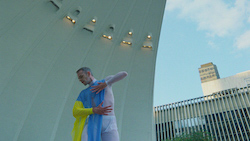
Pam Tanowitz choreographed a solo for NYCB Principal Russell Janzen for the New Works Festival, Solo for Russell — Sites 1-5. He danced at times in a white costume with a blue and a yellow streamer, and at times with warm-ups over that — abstract and highly architectural in design, just like much of the movement. When not abstract and architectural, much of it was pedestrian: simple stepping, gesturing and looking. At these times, I thought about a sole human in a grand space, tall and expansive structures towering over him.
I thought about the smallness of humans in the grandness of the universe, even with all of the mental and emotional potential and range that we contain. The raw practical, human elements also manifested in how Janzen brought Marley around the space with him — the “backstage” view, so to speak. This very human quality was also present when he extended a leg backward in arabesque or folded over it lengthening forward — yet when he danced something more technical, the presence of the dancer embodying his craft took on a new energy.
Seeing Janzen in warmups and then in full costume, in different frames and purposefully edited to feel delineated (it did feel like), felt like a philosophical separation of the dancer and the dance, the art and the artist. My mind could chew on it for ages! Close-up shots of feet, legs and Janzen’s facial expressions added visual intrigue to that intellectual interest.
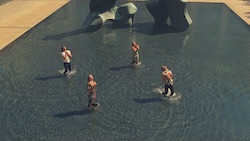
Andrea Miller’s new song was the most pleasant to experience for me as a viewer thus far in the festival. The movement had a virtuosity; a soaring arabesque like a bird’s wing snapping backward, backbends and turns without the slightest moment of unsteadiness or tension had my jaw genuinely dropping. Yet, there was also a suppleness and ease, a freedom of movement in the spine and hips, aligning beautifully with the Latin music and inflections in costumes — such as reds and blacks, high collars, long and form-fitting cuts. The architecture of the space also had a lovely parallel with the movement — the architecture of the body in the rock-solid and virtuosic technique as well as in the formations of diamond shapes, rectangles and circles. In this case, the safety need to stay distant perhaps contributed to a stunning and memorable architecture of humans in space.
Also prescient were sections of the dancers moving through water — able to rinse clean and provide for all life on earth. Combined with the yearning and resilient sense in the score, Miller’s work got to something elemental about being human. Even when we are not in physical contact, we are together in an architecture of space and energy. Apart from that, the work was aesthetically captivating. It drew all of me in — body, mind, heart and spirit.
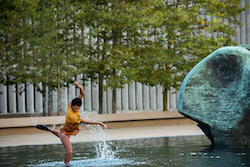
In Jamar Roberts’ Water Rite, NYCB Corps de Ballet Dancer Victor Abreu moved in a body of water, the same as in Miller’s work (premiered the night before). The music was staccato with a dramatic driving force, and Abreu’s movement followed suit — angular, staccato and quick.
Abreu’s movement quality, with a lovely sense of line and lift but also with a contemporary freedom through joints and an ease with moving through a variety of gestures and shapes, captivated me. The freedom and human elemental quality of dancing in water, it rippling and moving after and around Abreu, also took me right in. He reached an arm up and over while walking through water, plunged it in, and after a beat hit that arm backward to make a splash. A few counts later, he was turning, lunging and then rolling through his spine. I was completely absorbed in all of it.
Perhaps the most fascinating part of the work was the camera panning out at the end and the shot including the musicians, with their instruments, right in the water. It was striking to realize they’d been there all along, and it opened up an element of creating the work by showing us the people who created that element. Arguably, the more we see and learn about how a work is created, the more understanding of it and appreciation for it that we can have.

The final work of the festival was Justin Peck’s Thank You, New York. It began with dancers looking out over scenes of the city, sharing what it means to them. Their clothing was pedestrian, and I felt like I was in touch with these dancers’ raw humanity — at least part of it. Then they danced — in a park, in a warehouse, in an alley, on a rooftop, each solo in their own space. They moved quickly, giving a new meaning to allegro.
The speed conveyed a deep passion — these dancers’ deep passion for the city and the work of dancing that they do in it. It had a quality of dancing alone in a bedroom (like so many of us did as teenagers), yet those dancing were the pinnacle of ballet virtuosity and artistry. The locations also offered so much of New York’s unique beauty — from endlessly expansive sunsets to colorful and gritty back alleys and warehouses.
“Thank you, New York, may I have another dance with you,” the singer of the pop score sang out. It felt like these words were coming directly from the hearts of these dancers. Thank you, NYCB, for shifting course so that the public could experience new works from top-notch dance artists. Thank you for meeting the moment, for allowing this art form to truly be ever-evolving. Thank you to the spaces we dance in, for holding us and our energy. We couldn’t do it without you.
By Kathryn Boland of Dance Informa.


